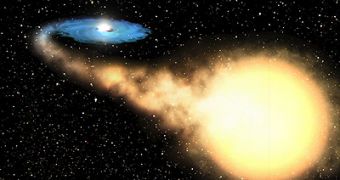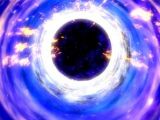The biggest black hole ever found in the universe weighs a staggering 18 billion times the mass of the Sun; however, NASA now discovered what seems to be the smallest black hole ever known. It has a mass 3.8 times that of the Sun and a diameter of about 24 kilometers. It was discovered with the help of NASA's Rossi X-ray Timing Explorer satellite back in 2001, inside a binary system, known as XTE J1650-500, within our galaxy.
Even though it was discovered more than seven years ago and was known to be a low-mass black hole, until now astronomers weren't able to measure it precisely. "This black hole is really pushing the limits. For many years astronomers have wanted to know the smallest possible size of a black hole, and this little guy is a big step toward answering that question," said study team leader Nikolai Shaposhnikov, from NASA's Goddard Space Flight Center.
Measuring effects
Black holes do not emit any electromagnetic radiation, thus they are invisible to our instruments. So, in order to approximate their properties, astronomers measure the effects produced by their powerful gravitational pull. For example, the process of estimating the size of a particular black hole involves calculations related to the apparent size of the object and the mount of X-ray light emitted by the accretion disk orbiting it.
Gas accreted from a nearby star is severely compressed as it spins around the black hole. Both friction and compressing lead to gas heating, which then starts to emit X-ray radiation. "So matter had to literally squeeze into the black hole," said Shaposhnikov. Nevertheless, the X-ray emission is not continuous; its intensity varies in time in repeating patterns, called quasi-periodic oscillation, which is in direct relation to the mass of the black hole.
The bigger the black hole, the wider the accretion disk of matter, so that in the end the quasi-periodic oscillation is slower than that of smaller black holes. The previous record for the smallest black hole was held by GRO 1655-40 with a mass of about 6.3 times that of the Sun.
Critical mass
Similarly to supermassive black holes, small black holes present valuable information for researchers; however, while in the case of supermassive black holes the issue was to find what is the upper limit of the black hole mass, astronomers are hopping to understand what is the critical mass for creating the smallest stable black hole in the universe. It is generally believed that this limit is somewhere between 1.7 and 2.7 times the mass of the Sun, representing the weight at which a star, respectively a neutron star, may produce a black hole.
"This new result brings us much closer to the theoretically predicted limit," said Shaposhnikov. "The question of black hole masses had concerned us for more than a decade now," said Northwestern University astrophysicist Vicky Kalogera. Kalogera adds that there should be in fact more low-mass black holes in the visible universe, but very few were ever observed.

 14 DAY TRIAL //
14 DAY TRIAL // 
